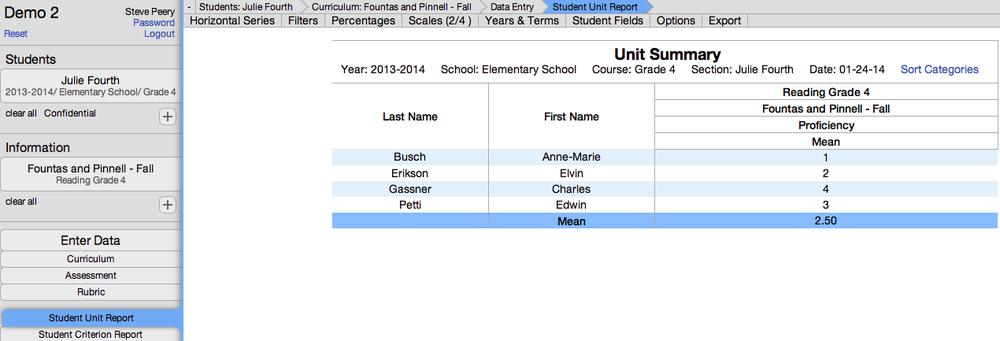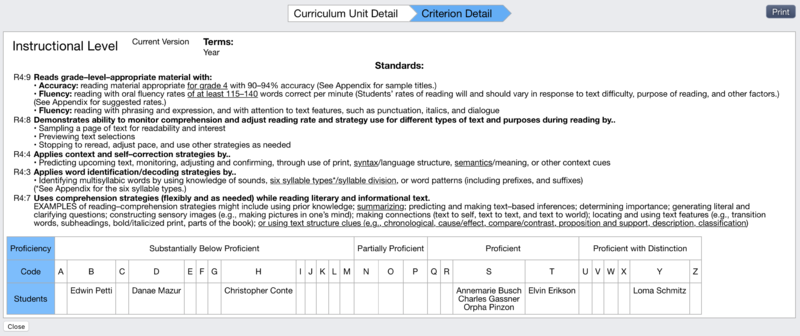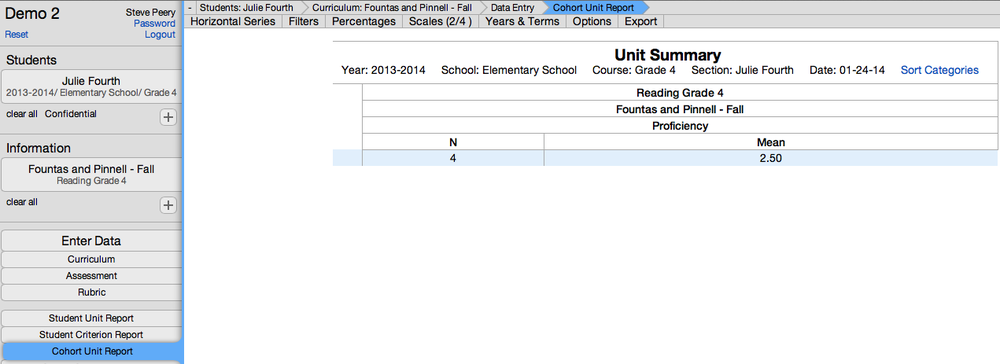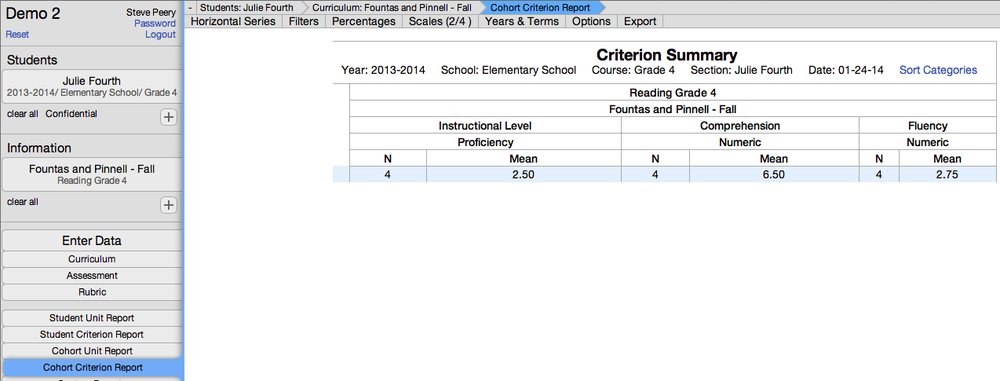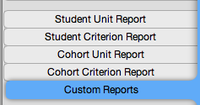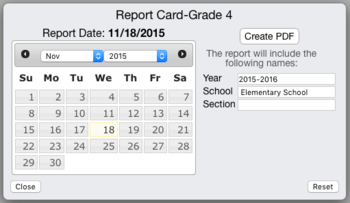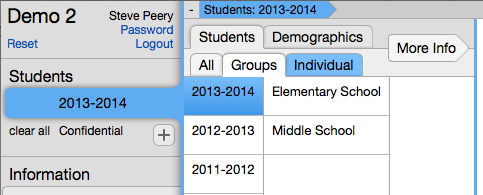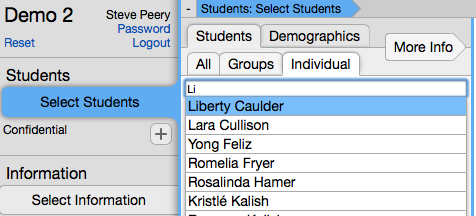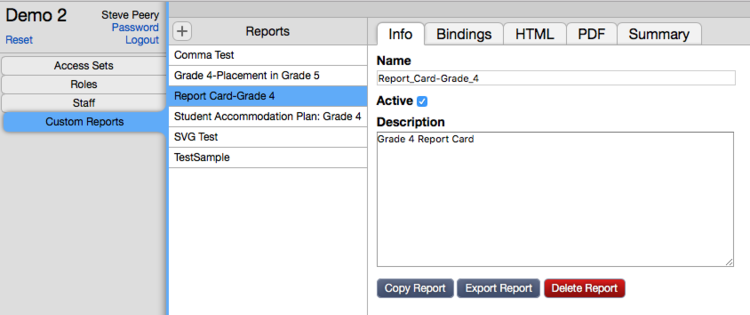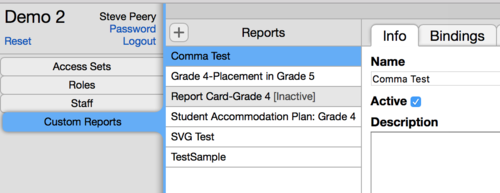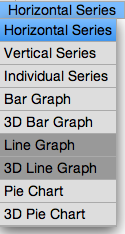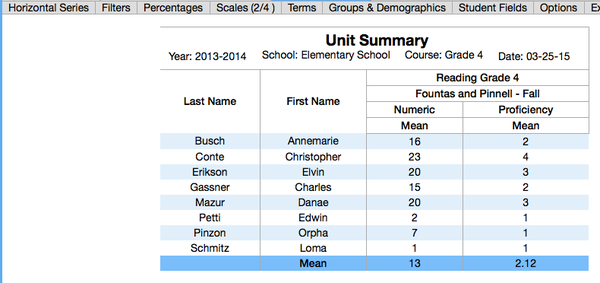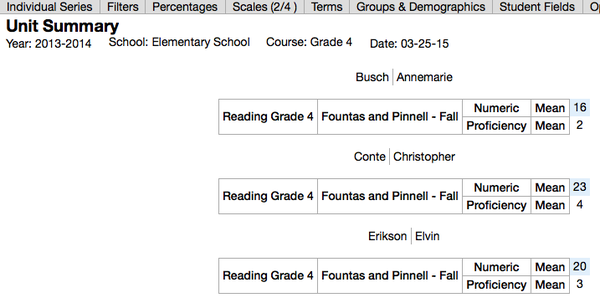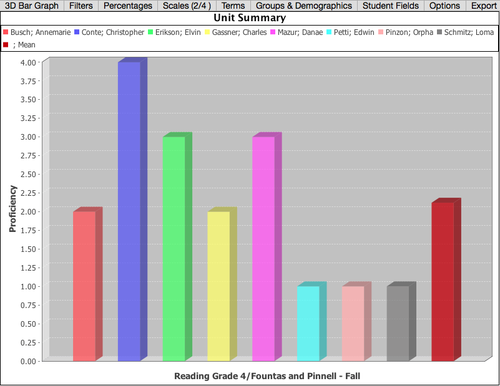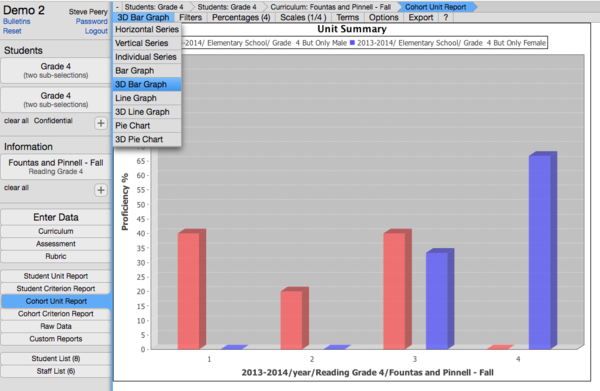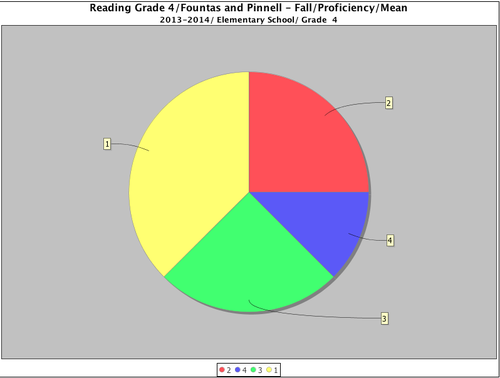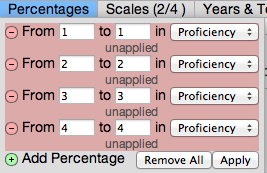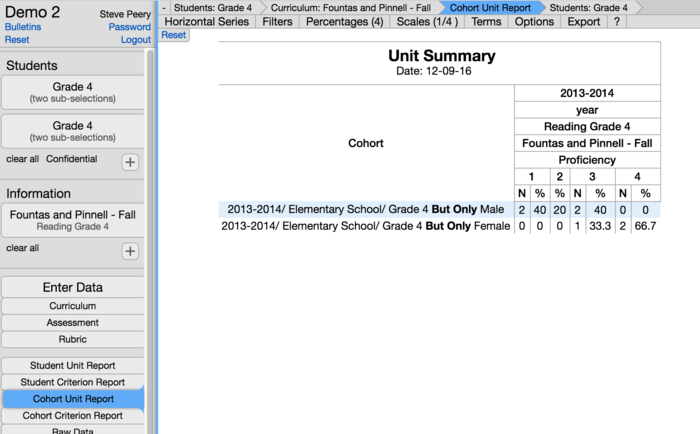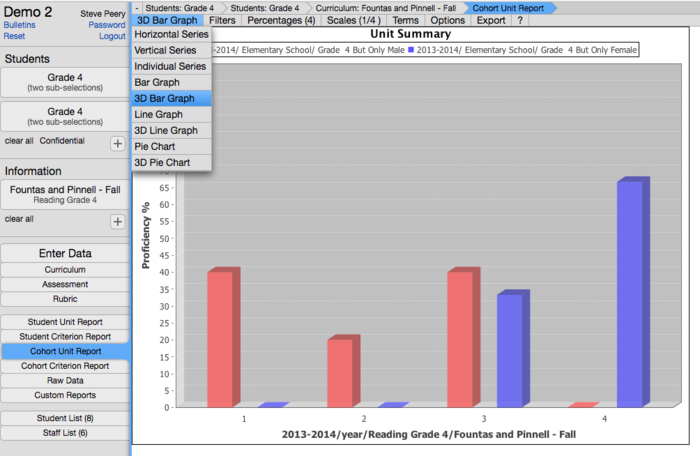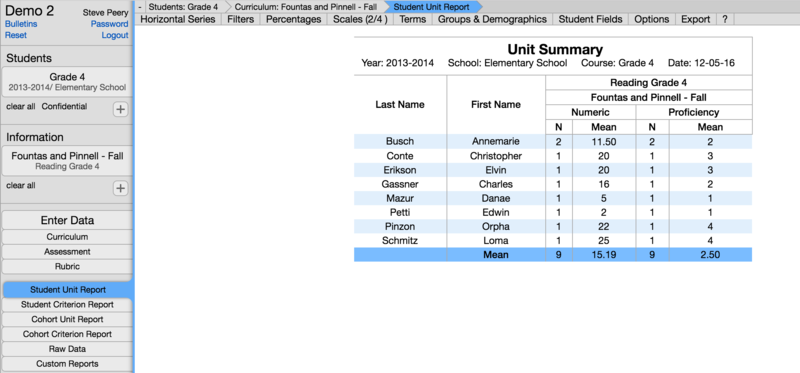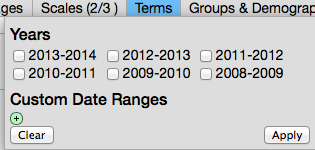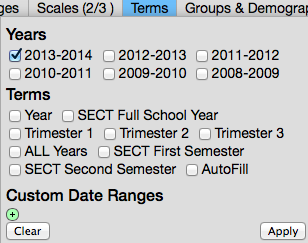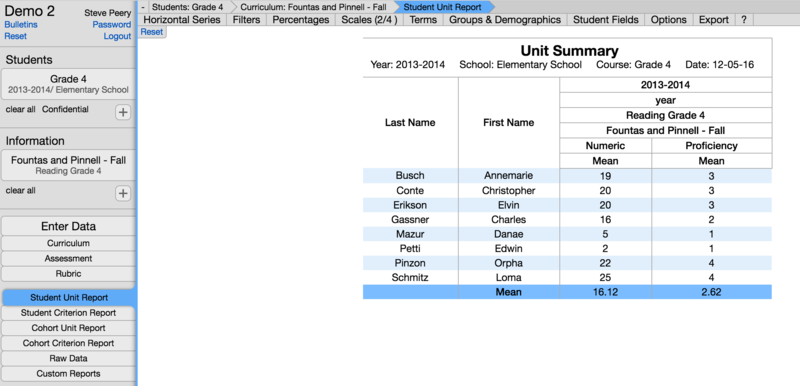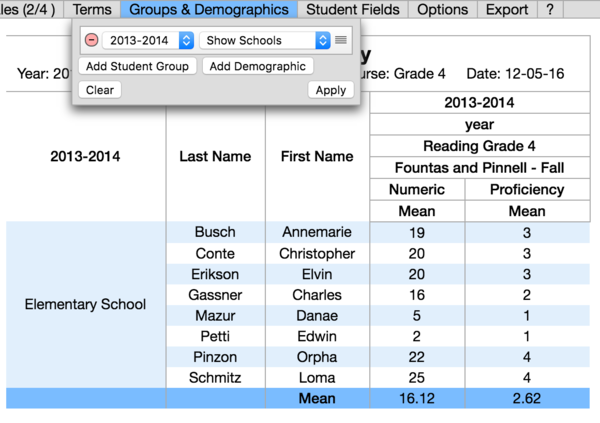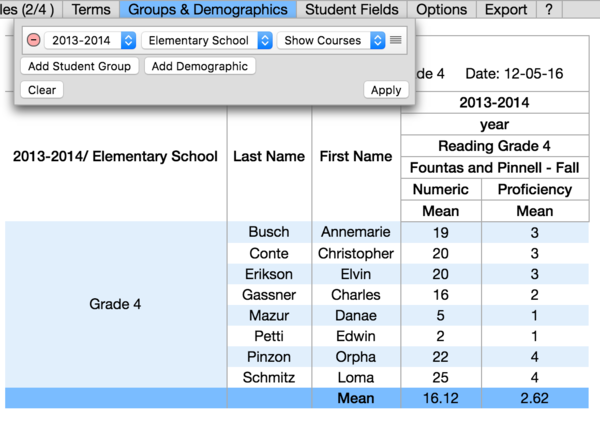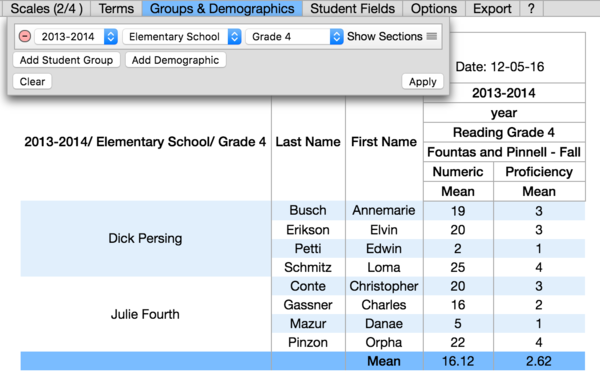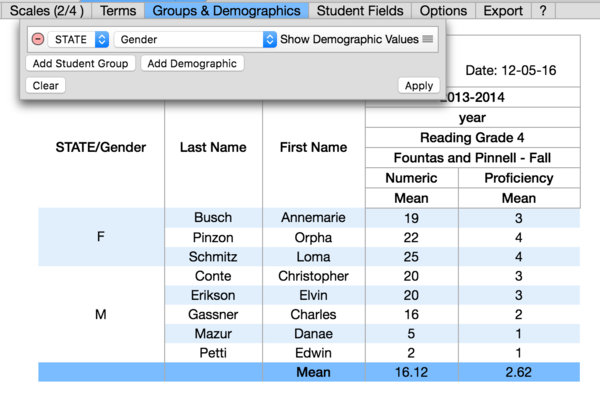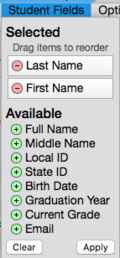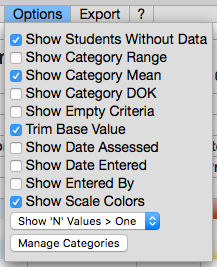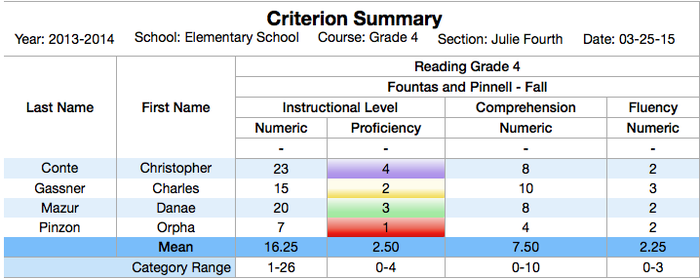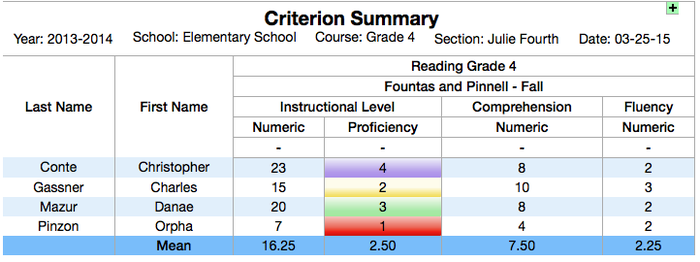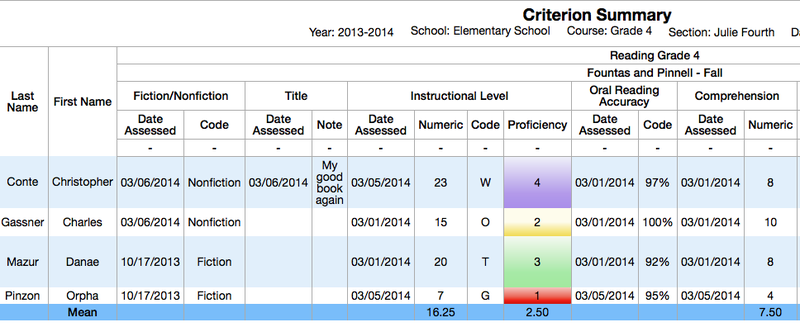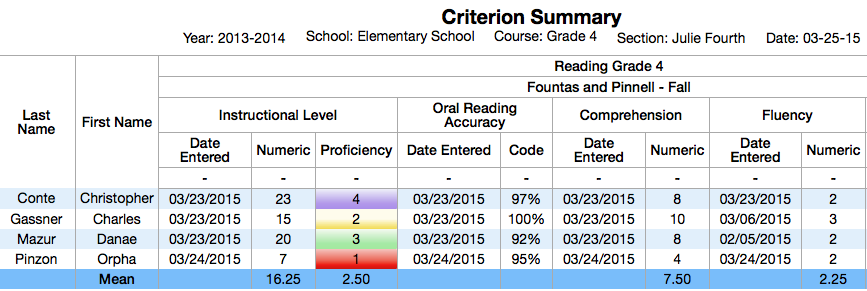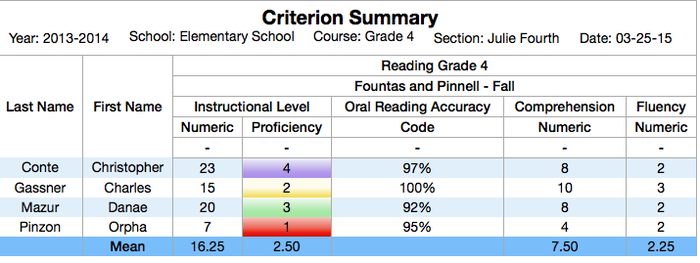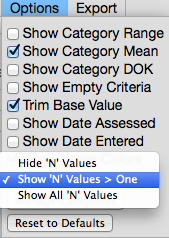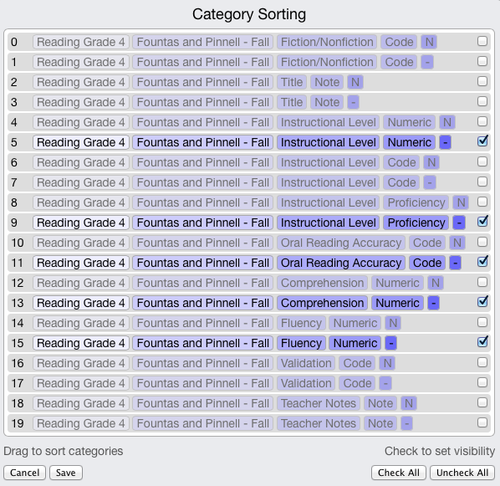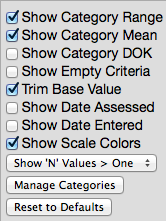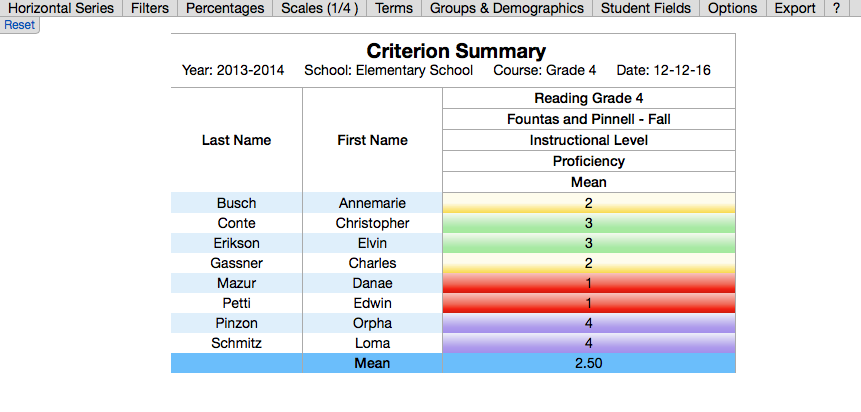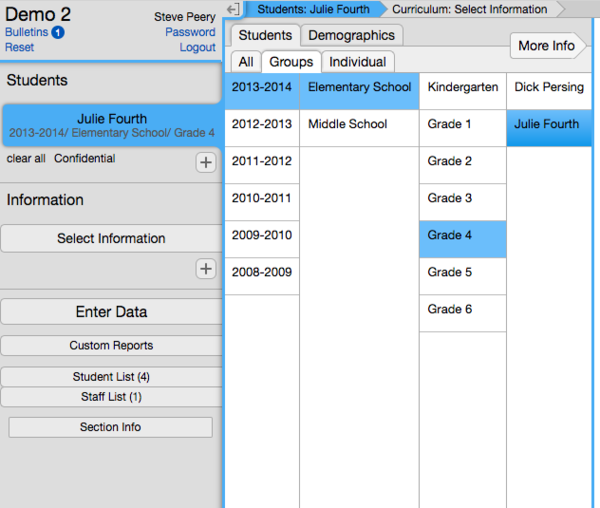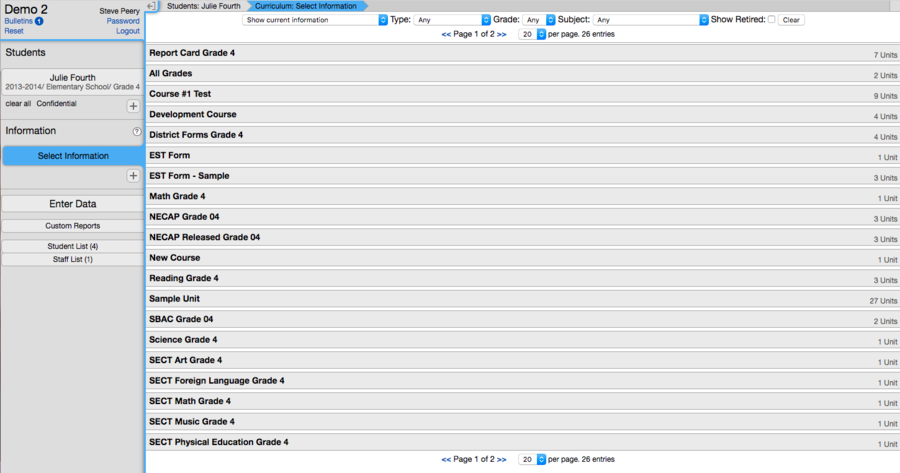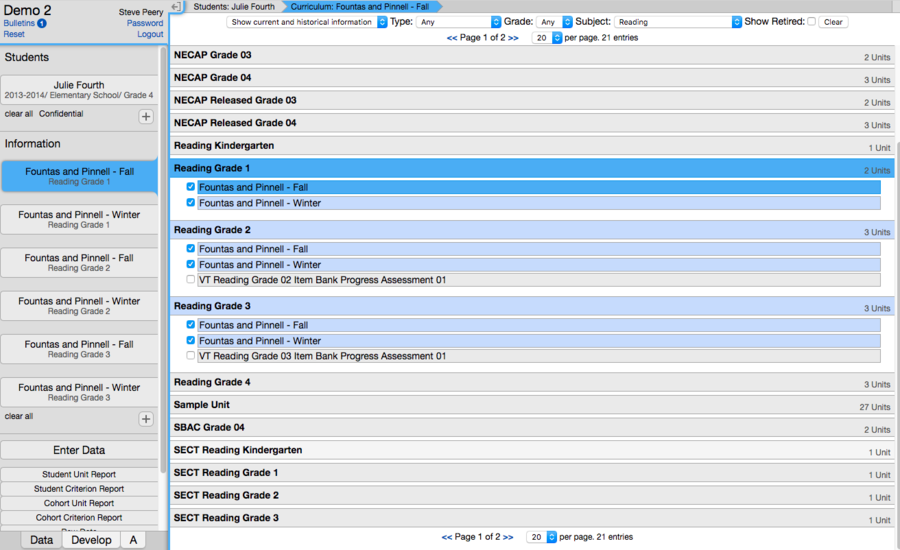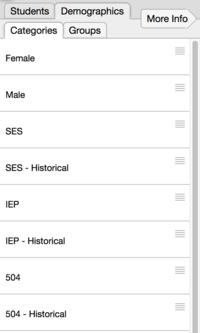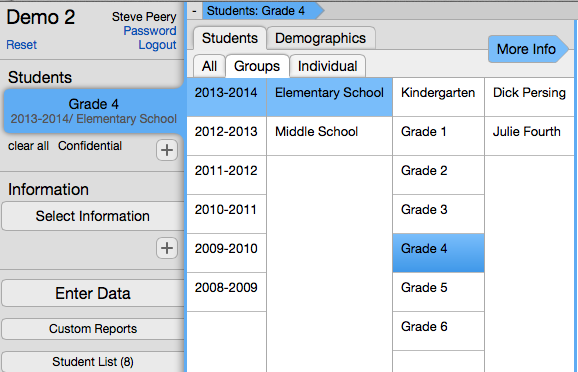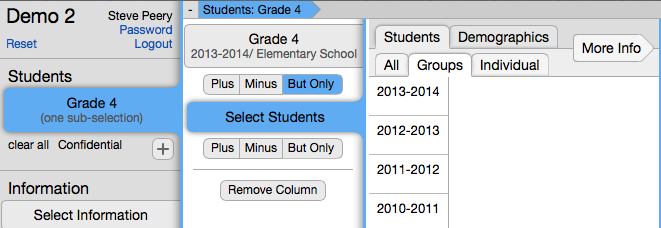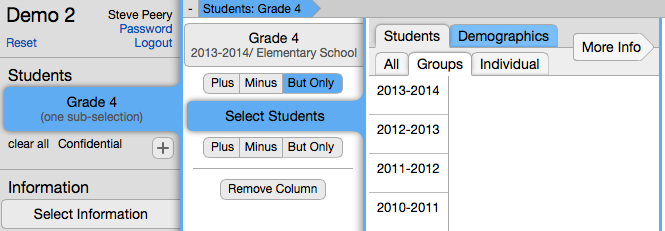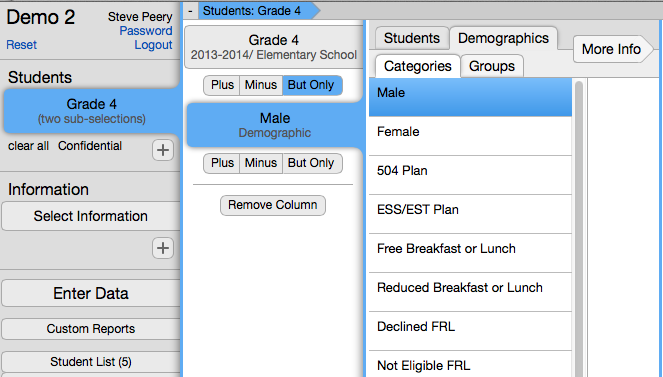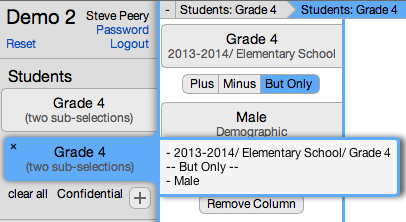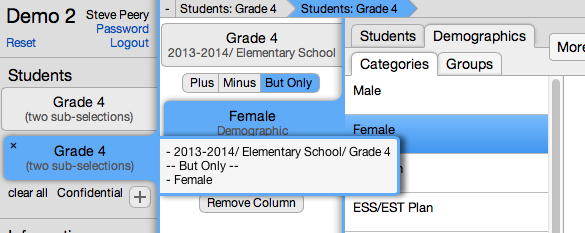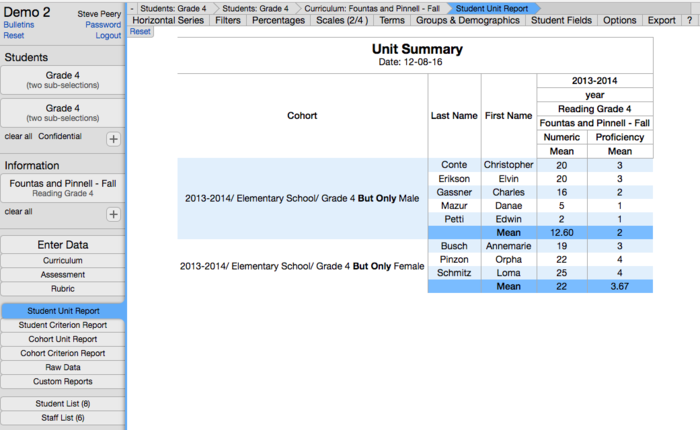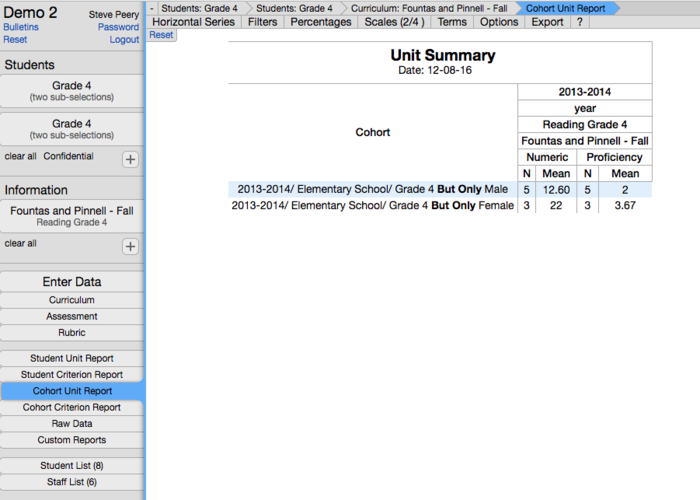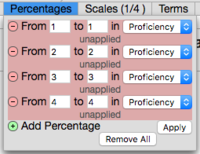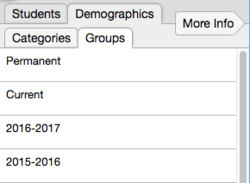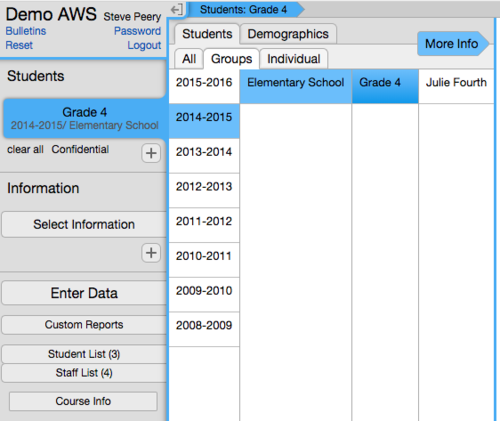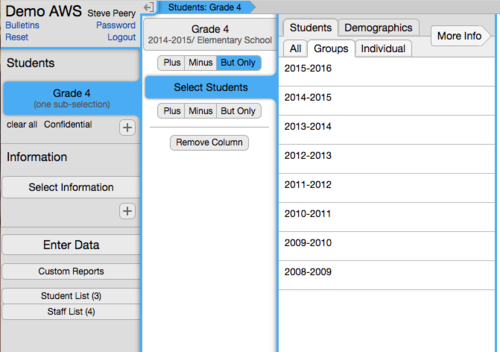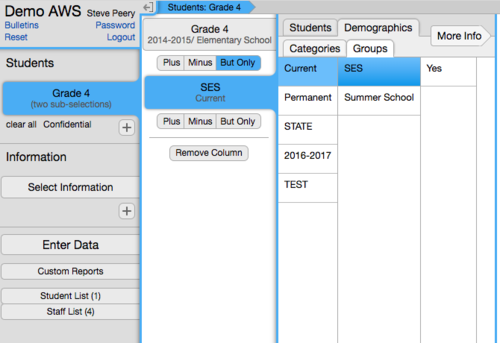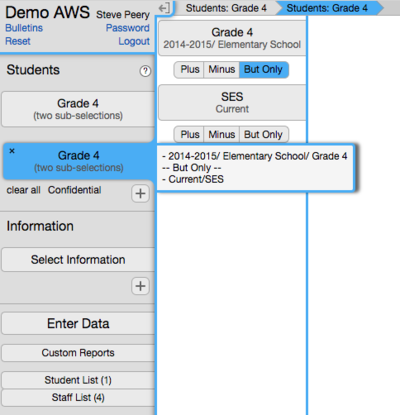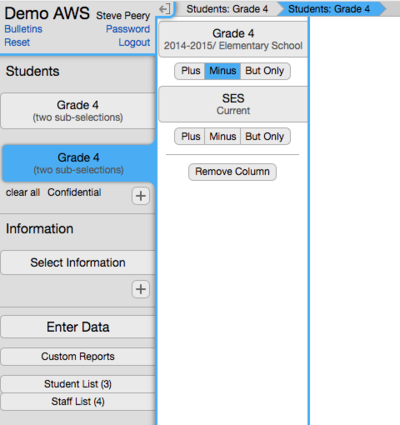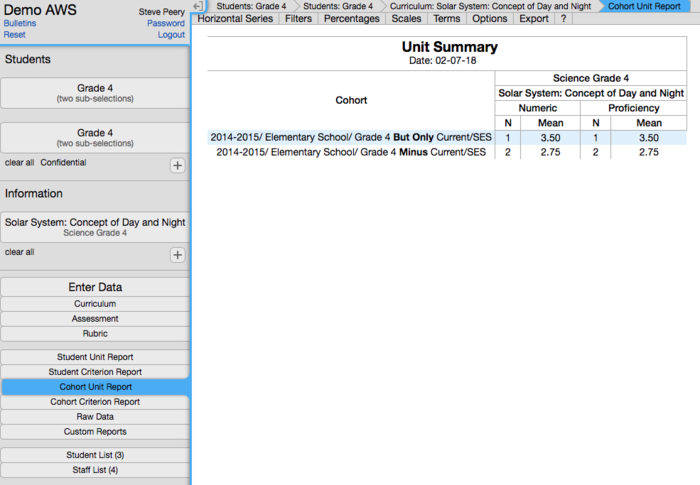Viewing Data
Contents
- 1 Options to View Data
- 2 Options to Refine Reports
- 3 Options to Export Reports
- 4 Sample Reports
Options to View Data
To View Data, you need to have selected the Students, and selected the Information you are interested in viewing for those students.
There are many options to view data in VCAT. Data can be viewed not only where you enter the data, but also using the following reports:
• Student Unit Report
• Student Criterion Report
• Cohort Unit Report
• Cohort Criterion Report
• Custom Reports
Student Unit Report
In this sample, one group of students is selected with one piece of information. Students are listed in alphabetical order using their last name. This Student Unit Report displays one student per row with one summarized value for the unit. The summarized value is dependent on the weight assigned to the criteria in the unit. If one criterion has all of the weight (100%), then that score will be used as the summary value to give a quick snapshot for that unit. If more criteria share the weight equally distributed (by default), the summarized value will be an average of the weighted criteria. Occasionally, none of the criteria are weighted. When that is the case, no summarized value can be calculated therefore, the Student Unit Report can't be generated. The bottom row highlighted in blue gives you the Mean (average) scores for the group of students you have selected. Many options are available to refine this report.
Student Criterion Report
In this sample, one group of students is selected with one piece of information. Students are listed in alphabetical order using their last name. This Student Unit Report displays one student per row with the detailed scores for each of the criteria in the unit in individual columns. The bottom row highlighted in blue gives you the Mean (average) scores for the group of students you have selected. Many options are available to refine this report.
Criterion Detail Report
1.When running a criterion report (student criterion report or cohort criterion report), hover over the criterion name (column header) with your mouse to see the little blue i appear on the left.
2.Click on the i to create the Criterion Detail report. If you wish to print this report, click on the print button at the top right corner.
Cohort Unit Report
In this sample, one group of students is selected with one piece of information. This report displays one cohort per row with the mean of the summarized values for the cohort. The 'N' of 4 indicates that there are 4 students with data included in the Mean. Many options are available to refine this report.
Cohort Criterion Report
In this sample, one group of students (cohort) is selected with one piece of information. This report displays one cohort per row with the mean score for each of the criteria with numeric scores in the unit. The 'N' indicates the number of students with data included in each of the criterion mean. Many options are available to refine this report.
Criterion Detail Report
1.When running a criterion report (student criterion report or cohort criterion report), hover over the criterion name (column header) with your mouse to see the little blue i appear on the left.
2.Click on the i to create the Criterion Detail report. If you wish to print this report, click on the print button at the top right corner.
Custom Reports
Custom Reports are reports specifically created and customized for your SU/district, and ready to download/print. Report Cards, Progress Reports, Placement Forms, and Student Accommodation Plan would be some examples of custom reports.
How to run a custom report for a group of students
1. Select the students.
2. Click on Custom Reports to get the list of custom reports available to you.
3. Select the custom report of your choice. The list can be filtered by Type, Grade, and/or Subject to narrow down the selection. Use the Clear button to the right of the Subject filter to cancel all filters.
4. After you have selected a report, you will be prompted with a calendar to select the date you wish to run the report for. Often times in custom reports, some values come straight from the student selection, like Year, School, Course, and Section. If the current student selection does not include any of these elements part of the report, the fields will be shown blank. Type in the information you wish to show on the report for those fields. Click on Create PDF to run the report.
How to run a custom report for Individual Student(s)
1. By default, you are under Groups tab where you can select the Year, School, Course, and Section. Click on Individual tab, to the right of the Groups tab.
2. Type first name OR last name (or part of either one) in the Search field. Click on the student name from the list displayed to select that student.
3. Now, the student's name shows up in the Students box and also on the right, with a little minus sign in a red circle. If you wish to remove that student, click on the red circle.
4. Repeat step 2 for each individual student you want to add.
The individual students selected show in one student box therefore, they are considered as one cohort.
5. Click on Custom Reports to get the list of custom reports available to you.
6. Select the custom report of your choice. The list can be filtered by Type, Grade, and/or Subject to narrow down the selection. Use the Clear button to the right of the Subject filter to cancel all filters.
7. After you have selected a report, you will be prompted with a calendar to select the date you wish to run the report for. Often times in custom reports, some values come straight from the student selection, like Year, School, Course, and Section. If your current student selection does not include any of these elements part of the report, the fields will be shown blank. Type in the information you wish to show on the report for those fields. Click on Create PDF to run the report.
Active / Inactive Custom Reports
Under the A tab, go to the Custom Reports section. Select the custom report. Under Info, there is an Active checkbox.
If you uncheck the Active box for the custom report selected, that report will become inactive. Every inactive custom reports will be marked with [Inactive] and shaded gray.
Under the Data tab, the Custom Reports list has an Active Only checkbox in the filter bar, at the top. By default, the Active Only box is checked and the list will only display the custom reports that are active.
If you uncheck the Active Only box, all inactive custom reports will be included in the Custom Reports list.
Options to Refine Reports
- Here are the options available in the top menu bar to help refine the reports:
Display Options (Horizontal Series by Default)
? --> clicking the question mark (?) in the top menu bar of the report will open a separate wingow and bring you directly to this section of the Wiki.
Display Options
Depending on the information, an option might be more suitable than another one to view that information. BEFORE changing the display, make any adjustments or modifications while in Horizontal Series.
Horizontal Series
• By default, you are on the 'Horizontal Series', which displays students on the left, in rows, and data in columns. It is recommended you make all adjustments needed prior to selecting a different display option.
• The dark grey shaded options in the drop-down when clicking on Horizontal Series indicate that they are not available, based on the selection.
Vertical Series
• The Vertical Series displays the information in rows and the students in columns.
Individual Series
• The Individual Series displays the information grouped by student.
Bar Graph and 3D Bar Graph
- Depending on the report you create, this type of graph can be used to display the information for individual students or student cohorts.
- At the top of the graph, you'll find the key to each color.
- If you wish to make changes to the settings for the report, select Horizontal Series to go back to the initial display and make the changes.
Pie Chart and 3D Pie Chart
- The ability to create pie charts in VCAT is very basic and colors are not consistent. It is strongly recommended that you export the data from your report to excel and use excel to build your pie charts with custom colors and settings.
Filters
• Click on the green '+' button to add a row that will give you options to filter the data.
• You have the option to 'Keep' or 'Hide' certain criteria based on their value/score in comparison to another value or item itself.
- You have the option to choose which criteria you want to focus on.
- You have the option to pick on the condition (equal, greater than, ...) to be met to isolate the students you want to focus on.
- You have the option to select a Number to focus on specific scores/values or an Item to compare two different criteria.
- The filter allows you to keep (or hide) students that may be just within a certain score range (example + or - 3 pts of a certain score).
- The filter is helpful to isolate students you want to look at. In the example below, the filter will keep students that had their proficiency dropped in their Winter assessment compared to their Fall assessment.
Percentages
- It can be helpful to look at the data from the report using Percentages. The example below is using Percentages to get the percentage of student cohorts for each proficiency level (1-4).
- Click on Percentages at the top.
- Click on + Add Percentage for each proficiency and set each row.
- Hit Apply to update the report.
- The default display of the report is in Horizontal Series. Click on Horizontal Series and select 3D Bar Graph.
- The key for the specific colors is at the top of the graph.
Scales
- Depending on what information you have selected when running reports, there is a variety of different scales that may be part of the report: Numeric, Code, Note, Proficiency, Stanine, Percentile,... , just to list the most common ones.
- By default, the report will include all the scales. To customize the selection, click on Scales in the menu bar at the top of the report, uncheck the ones you want to remove from the report, and click Apply.
Terms
- This feature can be used to limit the data you are looking at. For example, if a student has two pieces of data due to taking the assessment this year and the previous year, checking the current year under Terms would isolate his data and only the data coming from this year would be displayed. The student's last year's data would be ignored.
Sample of student with 2 years of data. By default, the system averages the student's scores:
- To limit the displayed data to the current year (or a specific year), go to Terms, in the option bar at the top, select the Year, and click on Apply:
- The data is then displayed for the year selected only:
- Notice that because there is only one piece of data for each student, the N values aren't showing. The default setting is for the N values to only show if there is more than 1. In this case, because one student had more than one piece of data (coming from 2 separate years), the N column appeared on the report.
- Note that, in this case, the curriculum rubric was using 'Year' as the term. If yours is using trimesters, for example, you may also want to check the Trimerster 1, 2, and 3 boxes before clicking Apply.
Groups & Demographics
- This feature is used to add student group information or demographic information to the student reports, if demographics information is kept in VCAT.
- This feature will not give you a 'mean' for a particular group, like Male vs Female for example. In order to get that information, you would need to select the students using a composite cohort with the gender.
- In the example below, the students were selected at the Grade level (all 4th graders):
Add Student Group
- Selecting the Year only, will allow the School name to show on the student report. Make your selection and click on Apply to see the student group on the student report. In this example, Elementary School is the actual name of the school.
- Selecting the Year, and the School, will allow the Course name to be displayed on the student report. Make your selection and click on Apply to see the student group on the student report. In this example, Grade 4 is the actual course name of the group selected.
- Selecting the Year, and the School, and the Course will allow the Section names to be displayed on the student report. Make your selection and click on Apply to see the student group on the student report. In this example, Dick Persing and Julie Fourth are the section names. In the Grade 4 course selected, these are the two sections.
Add Demographic
- To add a demographic - like Male and Female - to the students selected, click on Groups & Demographics. In this demo, the demographic set is called 'STATE' but, in reality, it would most likely be found under a demographic set called 'Permanent' for Gender and Race, or under a year specific demographic set (Current, 2015-2016, 2014-2015,...) for demographics like IEP, 504, SES,... In this example, I picked the demographic set (STATE), then the demographic name within that set (Gender), and F and M (the demographic values in this case) are displayed on the student report after I clicked on Apply:
- As mentioned at the very beginning of this Groups & Demographics section, this feature will not give you a 'mean' for a particular group, like Male vs Female for example. In order to get that information, you would need to select the students using a composite cohort with the gender.
Student Fields
- By default, student reports display Last Name and First Name, but other student fields are also available: Full Name, Local ID, State ID, Graduation Year, Current Grade, and Middle Name, Birth Date, and Email as well if the information is in VCAT.
- Click on Student Fields in the top menu bar - above the report, to edit.
- To add a new student field, click on the green circle with the + . Hit Apply to update the report.
- To remove a student field, click on the red circle with the - . Hit Apply to update the report.
- To change the order displayed on the report, click any selected student field (with the white background) and drag to reorder. Hit Apply to update the report.
- Click the Clear button to reset to the default student fields of Last Name and First Name.
Options
Show Students Without Data
- When running a student criterion report, you have the options to hide students without data. By default, Show Students Without Data is checked. To hide the students without data, just remove that check and it will update the report.
Show Category Range
- This option allows you to display on the report the range of the scores for each criterion.
Show Category Mean
- This option is checked by default. It shows the mean (average) score for each criterion for the student cohort selected.
Show Empty Criteria
- If there is no data for the information selected, the report will show those criteria anyway but, if part of the information selected has data and part of it doesn't, the criteria that do not have data will be hidden by default. In order to make them visible, 'Show Empty Criteria' has to be checked.
Show Date Assessed
- This option displays the Date Assessed on record for each data point.
Show Date Entered
- This option displays the date when each data point was actually entered.
Combine Versions
- This option is checked by default and combines versions. When unchecked, it will display in the header the detail of the version for which it found data. See the example below with NECAP data.
Show Scale Color
- This option is checked by default. It displays the colors associated with the proficiency scale if the criterion has defined proficiency levels for its values (scores/ratings).
Show 'N' Values
- By default, the 'N' column will only be displayed on the report if there is at least one 'N' value greater than 1, but you also have the option to hide or show all 'N' Values.
Manage Categories
- This option gives you the ability to quickly manually select criteria by checking or unchecking individual ones or all at once with 'Check All' or 'Uncheck All'. It includes a drag and order feature to let you sort the criteria as well. To do so, just click on the criterion and drag to where you want it.
Reset
- Reset to Default will show up under Options when custom settings are used. This option gives you the ability to remove at once all changes you have made using the filter bar. It will remove those settings and reset the report to its initial state.
- Another quick way to reset all settings applied to the report is by clicking on the Reset blue link, showing under Horizontal Series, in the top left corner of the report. The Reset blue link ONLY shows up if custom report settings have been used.
Export
- If you wish to export the report, click on Export, on the top right on the menu bar.
- Depending on the report, you may have all the export options or only some of them.
- For any graph, the only option available will be Export to PNG - which only provides a link to this Wiki to inform you that it can't be exported like the others.
- To save the graph, you will need to place your mouse over it, right-click to be able to save the image, OR copy and paste into a document, OR select your image and drag into a word document.
Options to Export Reports
Export to PDF
- This feature will export the report into a pdf format. Beware that if there is too much information on the report (what you currently have displayed on the screen), the information might not lay out correctly and may very well be illegible. If that's the case, return to the report and adjust the information selected and/or settings to reduce its size.
Export to Excel
- This feature allows you to export to excel (spreadsheet format) to give you the ability to manipulate the data file if needed. In excel, you can also create some custom reports like pie charts for example.
Export to PNG
Graphic reports and charts are simply pictures on a webpage. To export, right-click (control-click on Mac) on the picture and save the image to your disc. You can also copy and paste the image directly to a document editor like Microsoft Word.
Sample Reports
Report using Historical Data
- Either to learn more about incoming students or students' progress over time, it is helpful to run reports using historical data.
- The steps below are the same, regardless of the student(s) and information/assessment(s) you select.
1. Select the students
You can find more information on how to select students by clicking here.
2. Select the information
- Select the information you wish to view for the students you have selected. By default, the information list in the filter bar at the top will likely be on 'Show current information' or may also be on 'Show information for data entry'. In order to have access to select previous years data, change the information list to be on 'Show current and historical information'.
- If the list displayed is lengthy, you can also use the other filters, like the subject, to shorten the list and make it easier to get to the information you're interested in.
- If the information (assessment) you're looking for isn't displayed, it may have been retired. To have access to it, check the 'Show Retired' box at the top right of the report filter bar.
- You can find more on how to select information by clicking here.
3. Select the report
- Select the report that helps you with the kind of information you're looking to find out about the students you have selected.
Student Report VS Cohort Report
- If you want to look at student level data (individual students), select a Student Report - Student Unit Report OR Student Criterion Report.
- If you want to look at the data as a whole group together (no details on individual students), select a Cohort Report - Cohort Unit Report OR Cohort Criterion Report.
Unit Report VS Criterion Report
- A Unit Report is a 'summary' report. It will give one summarized value (score) for each information/assessment(s) selected, based on how the assessments are set up in VCAT. That summarized value can be, for example, the Text Level itself if it was determined to be the one most important score that would give a quick snapshot on student performance, or it could be a Total score for an assessment that has multiple questions.
- A Criterion Report is a detailed report of each score for each criterion of the information/assessment(s) selected.
To learn more, click on any of the reports below:
4. Show / Hide Side Panel
- It's sometimes helpful to hide the side panel in order to expand what is viewed on the screen - especially when looking at reports.
- The button to close and open the side panel has been redesigned with an arrow pointing left to close the left panel (column), or pointing right to reopen it.
- This is how the button looks when you hover over it with your mouse when the left side panel is showing:
- This is how the button looks when you hover over it with your mouse when the left side panel is hidden:
Report Using Demographics
Often, there is a need to view data not only for a group of students in its entirety but also for certain sub groups (Male, Female, Current IEP students, Current SES students,…) within that group.
If you do not have your own district/SU demographics in VCAT, but have the categories like Male, Female, IEP, and SES, they will only be related to the old NECAP demographics imported with the NECAP data.
Go to Demographics to learn more on how any demographic can be included and maintained in VCAT for your SU/District.
Gender
Gender can be accessed under the Demographics Categories. Typical categories would have Female and Male, and any other major demographics your SU/SD is keeping track of, distinguished as being historical (previous years) or not (current). Here's a sample:
In the steps below, a group of students gets broken down by Male and Female. The same steps could be followed using a different demographic category as well.
2. Click on the 'More Info' button/arrow above the section column.
Notice that this entire group of students has a total of 8 students (Student List).
3. Click on 'But Only'.
4. Click on 'Demographics' tab.
5. Click on 'Categories' sub tab. Select the 'Male' Category.
Notice that the Student List now displays 5 - out of the 8 we started with, 5 of them are Male.
Again, if you hover over the Students Box, you will get the detail of your students selection.
6. Click on the '+' under the Students box. It will add a cohort that is an exact copy of the one right above it that was just created.
7. Now click on the 'Male Demographic' box. It will bring up the next column with the demographic categories. Click on Female.
8. Select the information you want to view by clicking on Select Information box, in that very first column on the left.
9. Select a report. See different samples below.
Student Unit Report
Notice that you now have 2 cohorts: Grade 4 Male students and Grade 4 Female students. If you wanted, you could also add the Grade 4 students as a cohort (you would have 3 cohorts) so you could look at their data as a whole group, and compare it with the males and females from that group.
Cohort Unit Report
From this last sample, here are the next steps if you would be interested to look at the percentages for each proficiency level (1-4) for Male and Female:
- Click on Scales, in the menu bar at the top, uncheck all scales except Proficiency, and hit Apply.
- Click on Percentages, in the menu bar at the top, and add a row for each proficiency by clicking the + Add Percentage. Set them up with From 1 to 1, From 2 to 2, From 3 to 3, and From 4 to 4 in Proficiency and hit Apply.
- Click on Horizontal Series, in the menu bar at the top left, and select 3D Bar Graph.
The Key at the top of the 3D Bar Graph indicates that the red color is for the males, and the blue for the females. Visually, you can quickly see how both groups are divided. You can also hover over each bar to get the exact percentage. Returning to the Horizontal Series will provide you with all the values.
To learn more about options to refine your reports, click here.
Current Demographic
Although it looks different in the Demo VCAT example, keep in mind that the typical layout for demographics in a real SU/SD would resemble the ones below:
Demographics/Groups/Permanent 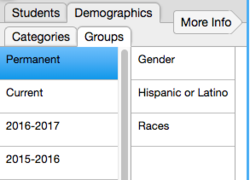 Demographics/Groups/Current
Demographics/Groups/Current 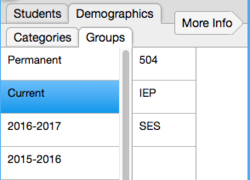
In the following example, two cohorts (4th graders part of SES, 4th graders NOT part of SES) are selected to compare their performance. If you're interested in a different demographic - IEP for example, follow the steps but choose Current IEP instead of Current SES.
2. Click on the 'More Info' button/arrow above the section column.
3. Click on 'But Only'.
4. Click on 'Demographics' tab, Groups, Current, and SES
5. Click on the '+' under the Students box. It will add a cohort that is an exact copy of the one right above it that was just created. If you hover over the Students Box, you will get the detail of your students selection.
6. Now click on 'Minus' button (to the left of 'But Only'), and keep SES. This group will be 4th graders that are NOT part of SES.
7. Select the information you want to view by clicking on Select Information box, in that very first column on the left.
8. Select a cohort report.
Cohort Unit Report Example
Here are the next steps if you were interested to look at the percentage of students proficient:
- Click on Scales, in the menu bar at the top, uncheck all scales except Proficiency, and hit Apply.
- Click on Percentages, in the menu bar at the top, and add a row by clicking the + Add Percentage. Set it up with From 3 to 4 in Proficiency and hit Apply.
- Click on Horizontal Series, in the menu bar at the top left, and select 3D Bar Graph.
The Key at the top of the 3D Bar Graph indicates that the color for the each cohort. Visually, you can quickly see how both groups performed. You can also hover over each bar to get the exact percentage. Returning to the Horizontal Series will provide you with all the values.
To learn more about options to refine your reports, click here.
